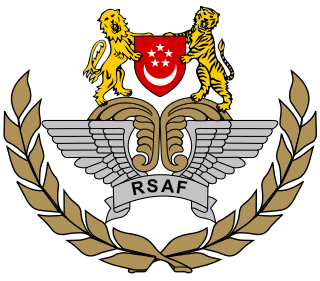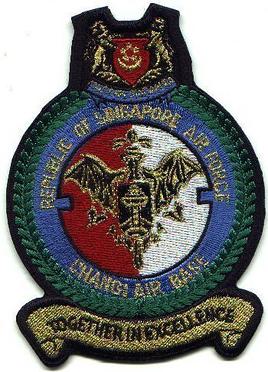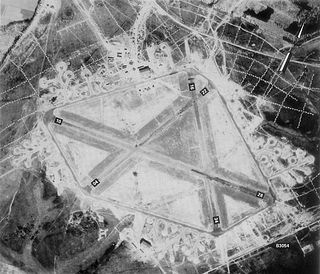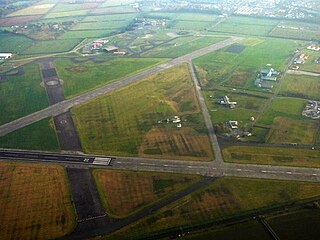
The former Royal Air Force Far East Air Force, more simply known as RAF Far East Air Force, was the Command organisation that controlled all Royal Air Force assets in the east of Asia. It was originally formed as Air Command, South East Asia in 1943 during the Second World War. In 1946, this was renamed RAF Air Command Far East, and finally Far East Air Force in June 1949.

The Republic of Singapore Air Force (RSAF) is the aerial service branch of the Singapore Armed Forces (SAF) responsible for controlling and defending the airspace of the country, and providing air support to the Army and Navy. It was established in 1968 as the Singapore Air Defence Command (SADC) before renaming to its current name in 1975. As the most powerful air force in Southeast Asia, the RSAF has undertaken a significant role in Singapore's military defence strategy since its formation.

The Paya Lebar Air Base is a military airbase of the Republic of Singapore Air Force (RSAF) and United States Air Force in Singapore located at Airport Road in Paya Lebar, in the eastern region of Singapore. The airbase goes by the motto of Strength Through Readiness.

Royal Air Force Syerston, commonly known as merely RAF Syerston, is a Royal Air Force station in the parish of Flintham, near Newark, Nottinghamshire, England. Opened in 1940, it was used by the Royal Air Force (RAF) as a bomber base during the Second World War, operating Vickers Wellingtons, Avro Manchesters, and the Avro Lancaster heavy bombers. Post-war, it became home to Jet Provosts of the 2 Flying Training School. It is now home to the Royal Air Force Central Gliding School.

Royal Air Force Wattisham or more simply RAF Wattisham was, between 1939 and 1993, the name of a Royal Air Force station located in East Anglia just outside the village of Wattisham, south of Stowmarket in Suffolk, England. During the Cold War it was a major front-line air force base, operating Quick Reaction Alert (South), before closing as an Royal Air Force station in 1993. Since 1993 it has been operated by the British Army as Joint Helicopter Command Flying Station Wattisham, or Wattisham Airfield.

The Tengah Air Base is a military airbase of the Republic of Singapore Air Force (RSAF) located in the Western Water Catchment, in the western part of Singapore.

The Sembawang Air Base is a military airbase of the Republic of Singapore Air Force (RSAF) located at Sembawang, in the northern part of Singapore. The base motto is Swift and Resolute.

Changi Air Base (East), or Changi East Complex is a facility extending the facilities of Changi Air Base, the existing facilities hence renamed Changi Air Base (West). Built on a 2 square kilometre site of reclaimed land, the new base was located approximately 2 kilometres east of Singapore Changi Airport and approximately 1.5 kilometres west of Changi Naval Base. Groundbreaking took place on 15 July 2002 and it was officially opened on 29 November 2004. A new runway (02R/20L) was built and the length was approximately 2,748 metres (9,015 ft), it has since been lengthened to 4,000 metres.

Royal Air Force Station Wildenrath, commonly known as RAF Wildenrath, was a Royal Air Force (RAF) military airbase near Wildenrath in North Rhine-Westphalia, Germany, that operated from 1952 to 1992. Wildenrath was the first of four 'clutch' stations built for the Royal Air Force in Germany during the early 1950s.

Army Aviation Centre (AAC) Middle Wallop is a British Army airfield located near the Hampshire village of Middle Wallop, used for Army Air Corps training. The base hosts 2 (Training) Regiment AAC and 7 (Training) Regiment AAC under the umbrella of the Army Aviation Centre. 2 (Training) Regiment performs ground training; 7 (Training) Regiment trains aircrew on AAC aircraft after they complete basic training at RAF Shawbury.

Royal Air Force Beaulieu or more simply RAF Beaulieu is a former Royal Air Force station in the New Forest, Hampshire, England. It was also known as Beaulieu airfield, Beaulieu aerodrome and USAAF Station AAF 408. It is located on Hatchet Moor 1 mile (2 km) west of the village of East Boldre, about 2 miles (3 km) west-southwest of the village of Beaulieu and 4 miles (6 km) north-east of Lymington.

Royal Air Force High Ercall or more simply RAF High Ercall is a former Royal Air Force sector station situated near the village of High Ercall, 7 miles (11 km) northeast of Shrewsbury, Shropshire, England.

Royal Air Force Upavon or RAF Upavon is a former Royal Air Force station in Wiltshire, England. It was a grass airfield, military flight training school, and administrative headquarters of the Royal Air Force. The station opened in 1912 and closed in 1993, when it was transferred to the British Army and became known as Trenchard Lines.

No. 205 Squadron was a Royal Air Force unit formed on 1 April 1918. Prior to this it had existed as No. 5 Squadron of the Royal Naval Air Service (RNAS). In 1929, it became the first RAF squadron to be permanently based in Singapore, taking as its motto Pertama di Malaya. No. 205 Squadron operated during World War II and the Cold War before disbanding on 31 October 1971.

The RAF Hal Far airfield was the first permanent airfield to be built on Malta. It was opened on 1 April 1929 as HMS Falcon, a Royal Navy stone frigate, and was used by Fleet Air Arm crews. It was transferred to the Maltese Government and redeveloped from January 1979. It is now closed and one of its runways is used by drag racing enthusiasts. The second runway is now a road leading to an industrial estate which was developed recently. The Maltese fire service, the CPD occupy the newer building with the glass control tower on the roof. The old Royal Naval Air Station building is now occupied by the International Safety Training College who utilise part of the runway for firefighting training.
Royal Air Force Catfoss, or more simply RAF Catfoss, is a former Royal Air Force station during the Second World War. It was located 4 miles (6.4 km) west of Hornsea, Yorkshire, England and 8 miles (13 km) north-east of Leconfield, Yorkshire, with the nearest village being Brandesburton.

RAF Holme-on-Spalding Moor, or more simply RAF Holme is a former Royal Air Force station located in the East Riding of Yorkshire, England.

Royal Air Force Ballykelly, or more simply RAF Ballykelly, is a former Royal Air Force station which opened in 1941 in Ballykelly, County Londonderry. It closed in 1971 when the site was handed over to the British Army as Shackleton Barracks. A small part of the base has been used as a refuelling point by army helicopters and small fixed-wing aircraft usually operating out of Joint Helicopter Command Flying Station Aldergrove near the town of Antrim.

Royal Air Force Church Fenton or RAF Church Fenton is a former Royal Air Force (RAF) station located 4.3 miles (6.9 km) south-east of Tadcaster, North Yorkshire, England and 6.3 miles (10.1 km) north-west of Selby, North Yorkshire, near the village of Church Fenton.





























